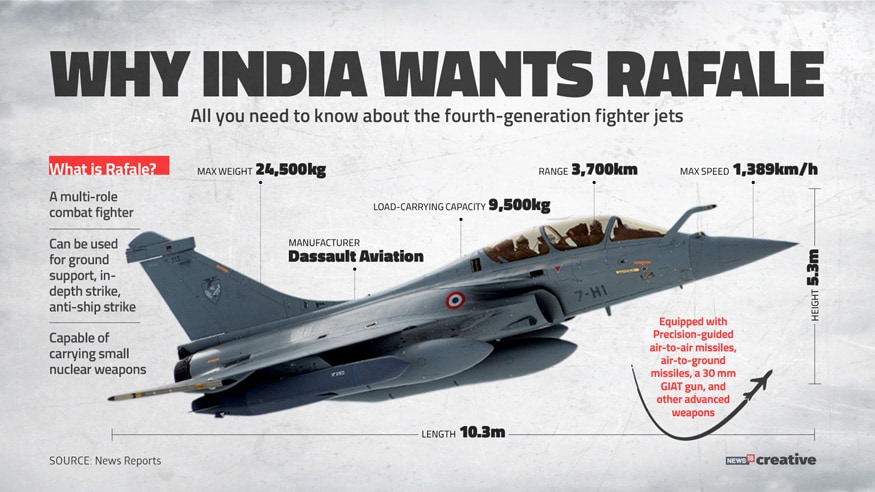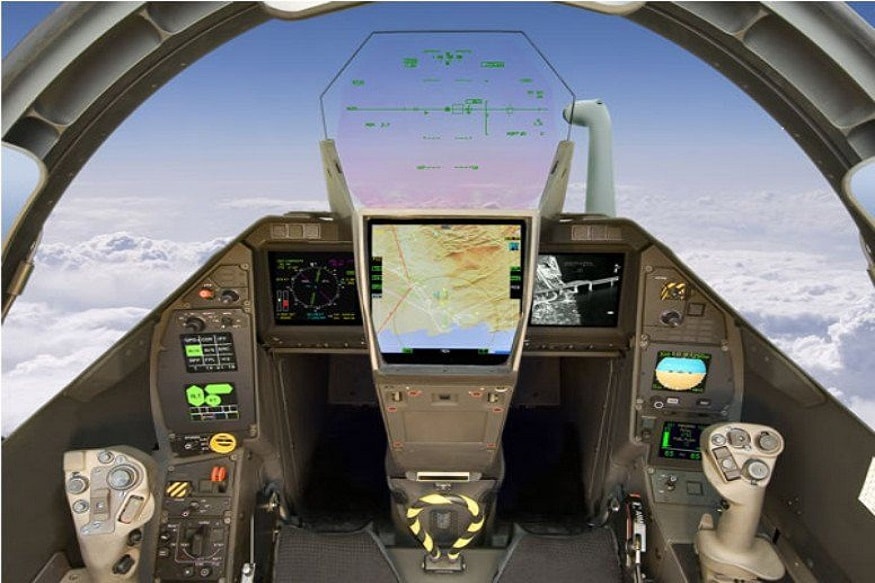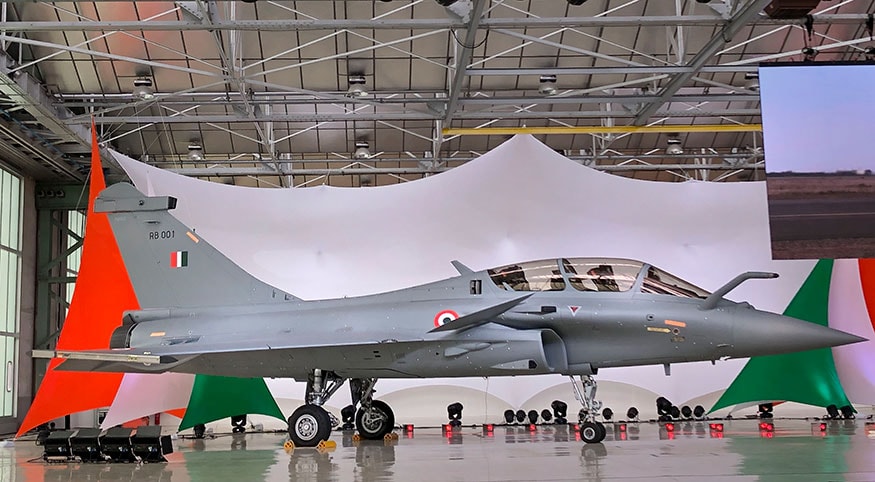Dassault Rafale: What Makes This Fighter Jet So Special For The Indian Air Force?

India chose Dassault Rafale over Lockheed Martin’s F-16 used by Pakistan Air Force, Boeing’s F/A-18, Eurofighter Typhoon, Russia’s MiG-35 and Sweden’s SAAB Gripen
Defence Minister Rajnath Singh received the first of 36 Rafale fighter jets and flew a sortie in the MMRCA fighter jet from a French airbase in Paris to gain first-hand experience of the aircraft. Rafale is handed over to Singh on the foundation day of the Indian Air Force. The first Rafale bears a tail number ‘RB 01', where 'RB' stands for Air Chief Marshal R.K.S. Bhadauria, who played an important role in negotiations for procuring 36 Rafale jets in the flyaway condition.
India had signed an inter-governmental agreement with France in September 2016 for procurement of 36 Rafale fighter jets at a cost of around Rs 58,000 crore. The aircraft is capable of carrying a range of potent weapons and missiles and the first squadron of the aircraft will be deployed at Ambala air force station, considered one of the most strategically located bases of the IAF. The Indo-Pak border is around 220 km from there. The second squadron of Rafale will be stationed at Hasimara base in West Bengal.
Here’s a look at the history and specifications of the Dassault Rafale to understand what makes this Fighter Jet so special for the Indian Air Force-
Importance of Rafale
After the Indian Air Force struck a Jaish-e-Mohammed camp in Balakot in February this year, Prime Minister Modi said, "Rafale fighters could have delivered even better results". His reference was apparently to the stealth of Rafale, an air-dominance aircraft manufactured by French aircraft manufacturer Dassault Aviation. Since India was waiting for deliveries of Rafale when the attacks happened, the Indian Air Force deployed a dozen Mirage-2000 aircraft, made by the same company to hit the targets.
Rafale is a Medium Multi-Role Combat Aircraft (MMRCA) that is said to boost India’s air dominance exponentially, currently safeguarded by fighter jets like Russia made Sukhoi Su-30MKI and MiG 29, along with French Mirage-2000 and indigenously built HAL Tejas.

A look at why India wants the Rafale combat aircraft
Origin of Rafale
Rafale is a French word meaning "gust of wind" and is a French-origin Delta winged, twin-engine multi-role fighter aircraft manufactured and designed by Dassault Aviation. The initial requirement of Rafale came into light in the mid-1970s, when both the French Air Force and Navy expressed a requirement for a new generation of fighters. In early ’80s Dassault was formally announced to build aircraft for the French government and the testing started in 1991. The production of the first aircraft series started in late 1992 but was suspended in 1995 due to political and economic uncertainty.
The production was restarted in 1997 after an initial order of 48 aircraft was placed by the Ministry of Defence followed by further order of 59 Rafale in 2004 and 60 aircraft in 2009. The French Air Force first operational Rafale squadron, EC 1/7 “Provence”, was stationed at Saint-Dizier airbase in 2006. Along with the French Military including Air Force and Navy, countries like Egypt and Qatar are the current operators of the Rafale MMRCA, while India will join the list this year itself.
Combat Proven
The Dassault Rafale has been combat-proven and has actively taken part in many wars in the last 13 years. From 2006 to 2011, French Air Force and Navy Rafale fighters were engaged in countless combat missions in Afghanistan where they demonstrated a high proficiency. In 2011, French Air Force and French Navy Rafale fighters were engaged in coalition operations over Libya. They were the first fighters to operate over Benghazi and Tripoli and carried out the whole spectrum of missions. French Air Force Rafales have taken a leading role in Mali, helping destroy enemy infrastructure and support friendly troops in contact. More recently, Rafales were engaged in support of peace-keeping operations in the Central African Republic, and as part of a wide international coalition in Iraq.
India And Rafale Deal
Though the idea to induct additional fighter jets in the IAF has been since 2001, the actual process began in 2007. The current IAF fleet largely consists of heavy and light-weight combat aircraft. So the defence ministry considered bringing in intermediate medium-weight fighter jets. The Defence Acquisition Council, headed by then Defence Minister AK Antony, approved the ‘Request For Proposal’ to buy 126 aircraft in August 2007. This kick-started the bidding process. The plan included acquiring 126 aircraft, 18 of them in fly-away condition and the rest to be made in India at the Hindustan Aeronautics facility under transfer of technology.

Dassault’s Rafale was not India’s only choice as several international aviation manufacturers expressed interest upon knowing the Indian government’s mammoth plan to revamp its air force fleet by introducing MMRCAs. Six renowned aircraft manufacturers competed to bag the contract of 126 fighter jets, which was touted to be the largest-ever defence procurement deal of India. The initial bidders were Lockheed Martin’s F-16s, Boeing’s F/A-18s, Eurofighter Typhoon, Russia’s MiG-35, Sweden’s Saab’s Gripen and Dassault’s Rafale.
All aircraft were tested by the IAF and after careful analysis on the bids, two of them — Eurofighter and Rafale — were shortlisted. Dassault bagged the contract to provide 126 fighter jets as it was the lowest bidder and the aircraft was said to be easy to maintain. After Rafale won the contract, the Indian side and Dassault started negotiations in 2012. Though the initial plan was to buy 126 jets, India scaled it down to 36, that too in ready condition. The first squadrons of the Rafale are set to join the IAF fleet by 2019.

Specifications
The Rafale is a modern fighter jet known for its agility, speed, weapon holding capacity and attack capability. The Dassault Rafale has a delta wing design and is capable of g-forces as high as 11g (in case of emergency). The Rafale is available in both single and dual seating cabin (India ordered 28 single and 8 dual seater Rafale). The Rafale is 15.27 metre long and a wingspan of 10.80 metre. The empty weight of Rafale ranges from 9,900 kg to 10,600 kg depending on the variant and maximum take-off weight of 24,500 kg.
The Rafale is powered by two SNECMA M88 engines, each capable of providing up to 50 kilonewtons (11,000 pounds-force) of dry thrust and 75 kN (17,000 pounds-force) with afterburners. The engines push the Rafale to attain a high speed of 1.8 Mach (1912 kph) and a range of more than 3700 km with 3 drop tanks.

Dassault has also loaded the Rafale with a Martin-Baker Mark 16F "zero-zero" ejection seat, capable of operation at zero speed and zero altitude. In terms of weapons, the Rafale can be equipped with air-to-air missiles, air-to-ground missiles, and air-to-surface missiles along with Nuclear weapons. For avionics, the Rafale is also equipped with AESA radar, SPECTRA Electronic Warfare System and IRST System.
The Rafale jets will come with various India-specific modifications, including Israeli helmet-mounted displays, radar warning receivers, low band Jammers, 10-hour flight data recording, infra red search and tracking systems among others.



No comments:
Post a Comment